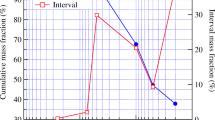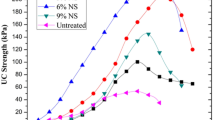Abstract
As a high-efficiency and environment-friendly stabilizer material, ionic soil stabilizer (ISS) has been widely used in construction industries. However, the microstructure characteristics and mechanical behavior of the treated soil still need a case study based on vary characteristics of soils and different treatments. In this paper, microscopic and macroscopic testing methods were adopted to explore the microstructure characteristics and mechanical behavior of the acidic ISS-treated clay versus the traditional alkaline lime and cement-treated clay. The results indicate that the soil particles become much more flocculated because of the ion exchange reaction between the soil and the ISS relying on the unique molecular structure of the ISS. The unconfined compressive strength (UCS) significantly increases, but still could not satisfy the requirement of road bearing capacity. However, the UCS improves rapidly with the increase of alkaline lime and cement. In addition, there is a benefit-period when the UCS of acidic and alkaline stabilizer-treated soil is greater than that of lime and cement-treated soil, whereas the strength of lime and cement-treated soil is lower than that of the combined treated one after this period. This study investigates the microstructure characteristics and mechanical behavior of the ISS-treated clay, which provides a theoretical and scientific support for appropriate road construction.












Similar content being viewed by others
References
Ahmad KB (2004) Improvement of a tropical residual soil by electrokinetic process. Doctoral dissertation, UniversitiTekno-logi Malaysia
Ahmad KB, Taha MR, Kassim KA (2011) Electrokinetic treatment on a tropical residual soil. Proc Instit Civil Eng-Ground Improv 164(1):3–13
Arabani M, Haghi AK, Hashemi SA, Karami M, Nikookar M, Bahari M (2012) Properties of clayey soils stabilized by liquid ionic stabilizer. In Conference: 3rd International Conference on New Developments in Soil Mechanics and Geotechnical Engineering, pp. 28–30
Argu Y (2008) Stabilization of light grey and red clay subgrade soil using SA-44/LS-40 chemical and lime. Doctoral dissertation, Addis Ababa University
Blanck G, Cuisinier O, Masrouri F (2014) Soil treatment with organic non-traditional additives for the improvement of earthworks. Acta Geotech 9(6):1111–1122
Bobet A, Hwang J, Johnston CT, Santagata M (2011) One-dimensional consolidation behavior of cement-treated organic soil. Can Geotech J 48(7):1100–1115
Brunauer S, Emmett PH, Teller E (1938) Adsorption of gases in multimolecular layers. J Am Chem Soc 60(2):309–319
BS1377 (1990) British standard methods of test for soils for civil engineering purposes. British Standards Institution, London
Campbell A, Jones D (2011) Soil stabilization in low-volume roads: obstacles to product implementation from additive supplier’s standpoint. Transp Res Rec 2204(1):172–178
Chew SH, Kamruzzaman AHM, Lee FH (2004) Physicochemical and engineering behavior of cement treated clays. J Geotech Geoenviron 130(7):696–706
Eisazadeh A, Kassim KA, Nur H (2011) Characterization of phosphoric acid-and lime-stabilized tropical lateritic clay. Environ Earth Sci 63(5):1057–1066
Eisazadeh A, Kassim KA, Nur H (2012) Cation exchange capacity of phosphoric acid and lime stabilized montmorillonitic and kaolinitic soils. Geotech Geol Eng 30(6):1435–1440
Harris P, Scullion T (2009) Stabilizer diffusion in swelling soils. 2009 International Foundation Congress and Equipment Expo: Contemporary Topics in Ground Modification, Problem Soils, and Geo-Support (ASCE) pp 566–573
Higo Y, Oka F, Kimoto S, Sanagawa T, Matsuhima Y (2011) Observation of microstructural changes and strain localization of unsaturated sands using microfocus X-ray CT. In: Advances in Bifurcation and Degradation in Geomaterials. Springer, Dordrecht, pp 37–43
JCPDS (1995) Index to the powder diffraction file. International Center for Diffraction Data, Swarthmore
Jiang T, Zhou Y, Liang S, Liu H, Han B (2009) Hydrogenolysis of glycerol catalyzed by Ru-Cu bimetallic catalysts supported on clay with the aid of ionic liquids. Green Chem 11(7):1000–1006
Katz LE, Rauch AF, Liljestrand HM, Harmon JS, Shaw KS, Albers H (2001) Mechanisms of soil stabilization with liquid ionic stabilizer. Transp Res Rec 1757(1):50–57
Latifi N, Eisazadeh A, Marto A (2014) Strength behavior and microstructural characteristics of tropical laterite soil treated with sodium silicate-based liquid stabilizer. Environ Earth Sci 72(1):91–98
Latifi N, Marto A, Eisazadeh A (2015) Analysis of strength development in non-traditional liquid additive-stabilized laterite soil from macro-and micro-structural considerations. Environ Earth Sci 73(3):1133–1141
Luo X, Qiu X, Wang Y, Wu J, Xiao S (2016a) Micro-treatment mechanism study on ionic soil stabilizer improving clay. Key Eng Mater 667:370–375
Luo X, Yang Q, Qiu X, Xiao S (2016b) Detecting and expressing of asphalt materials modulus considering temperature effect. Key Eng Mater 667:347–352
Mgangira MB, Ndibewu P (2010) Identification of microscale characteristics of treated subgrade materials and how they relate to macroscopic properties. 29th Southern African Transport Conference (SATC 2010), Pretoria, South Africa
Mitchell JK, Soga K (2005) Fundamentals of soil behavior, 3rd edn. Wiley, New York
Moloisane RJ, Visser AT (2014) Evaluation of the strength behaviour of unpaved road material treated with electrochemical-based non-traditional soil stabilisation additives. J South Afr Inst Civil Eng 56(1):28–39
Mutaz E, Shamrani MA, Puppala AJ, Dafalla MA (2011) Evaluation of chemical stabilization of a highly expansive clayey soil. Transp Res Rec 2204(1):148–157
Onyejekwe S, Ghataora GS (2015) Soil stabilization using proprietary liquid chemical stabilizers: Sulphonated oil and a polymer. Bull Eng Geol Environ 74(2):651–665
Prusinski JR, Bhattacharja S (1999) Effectiveness of Portland cement and lime in stabilizing clay soils. Transp Res Rec 1652(1):215–227
Rauch AF, Harmon JS, Katz LE, Liljestrand HM (2002) Measured effects of liquid soil stabilizers on engineering properties of clay. Transp Res Rec 1787(1):33–41
Rauch AF, Katz LE, Liljestrand HM (2003) An analysis of the mechanisms and efficacy of three liquid chemical soil stabilizers. Center for Transportation Research, The University of Texas, Austin
Tao JQ, Lin WY, Luo XH, Qiu X, Wu JH (2016) Compressive strength analysis of ionic soil stabilizer improving soil. Key Eng Mater 667:341–346
Tingle JS, Santoni RL (2003) Stabilization of clay soils with nontraditional additives. Transp Res Rec 1819(1):72–84
Yang Q, Luo X, Qiu X (2016) Analysis on mechanical behavior characteristics of stabilized clay under the coexistence condition of acidic and alkalic additives. J Highway Transpo Res Dev 6:8
Zhang T, Xu YY, Wang H (2012) Application and curing mechanism of soil stabilizer. Adv Mater Res 557:809–812
Zhao H, Ge L, Petry TM, Sun YZ (2014) Effects of chemical stabilizers on an expansive clay. KSCE J Civ Eng 18(4):1009–1017
Funding
This work was financially supported by the Natural Science Foundation of Zhejiang Province (LY18E080020 and LQ20E080009), the Key Laboratory of Infrastructure Durability and Operation Safety in Airfield of CAAC (MK201901), and the Zhejiang Provincial Key Laboratory of Urban Rail Transit Intelligent Operation and Maintenance Technology & Equipment.
Author information
Authors and Affiliations
Corresponding authors
Additional information
Responsible Editor: Amjad Kallel
Rights and permissions
About this article
Cite this article
Luo, X., Xu, W., Qiu, X. et al. Exploring the microstructure characteristics and mechanical behavior of the ionic soil stabilizer-treated clay. Arab J Geosci 13, 729 (2020). https://doi.org/10.1007/s12517-020-05708-w
Received:
Accepted:
Published:
DOI: https://doi.org/10.1007/s12517-020-05708-w




